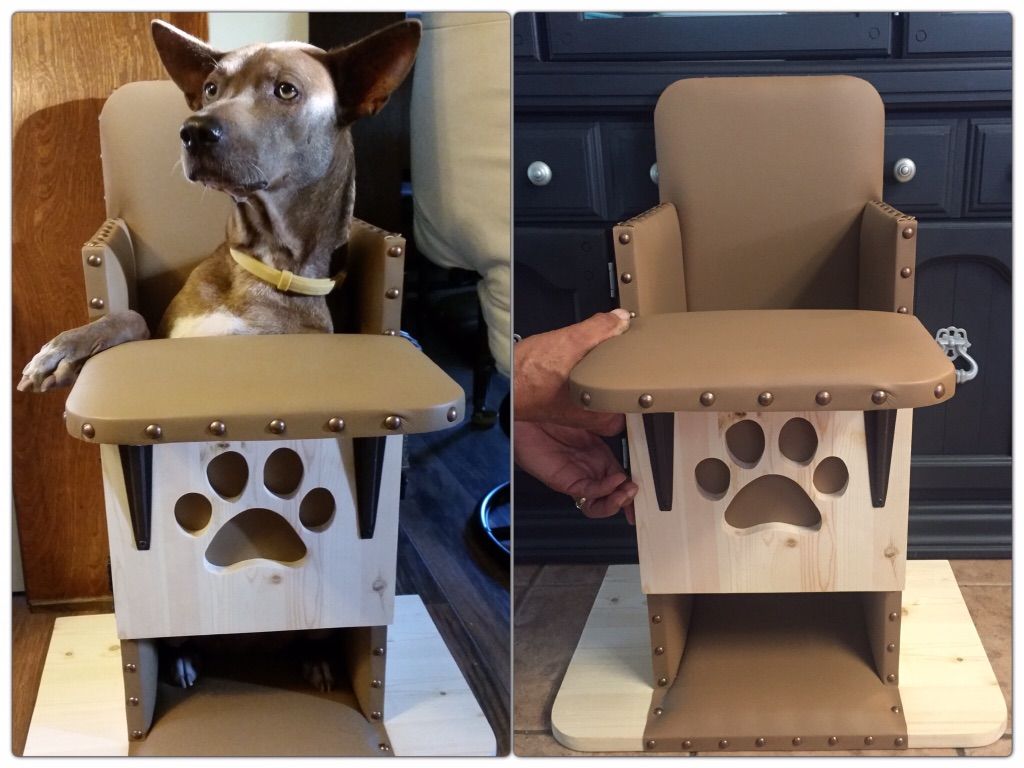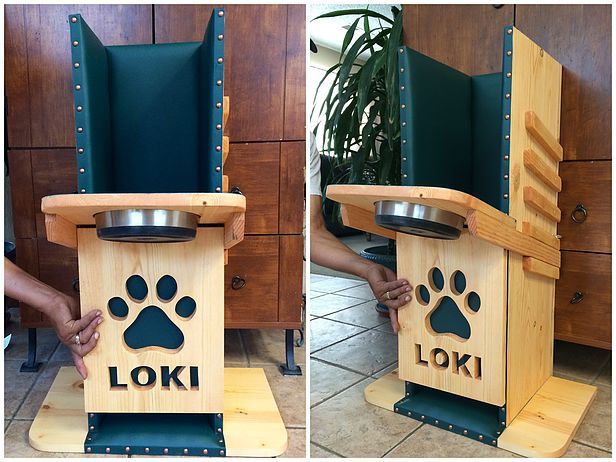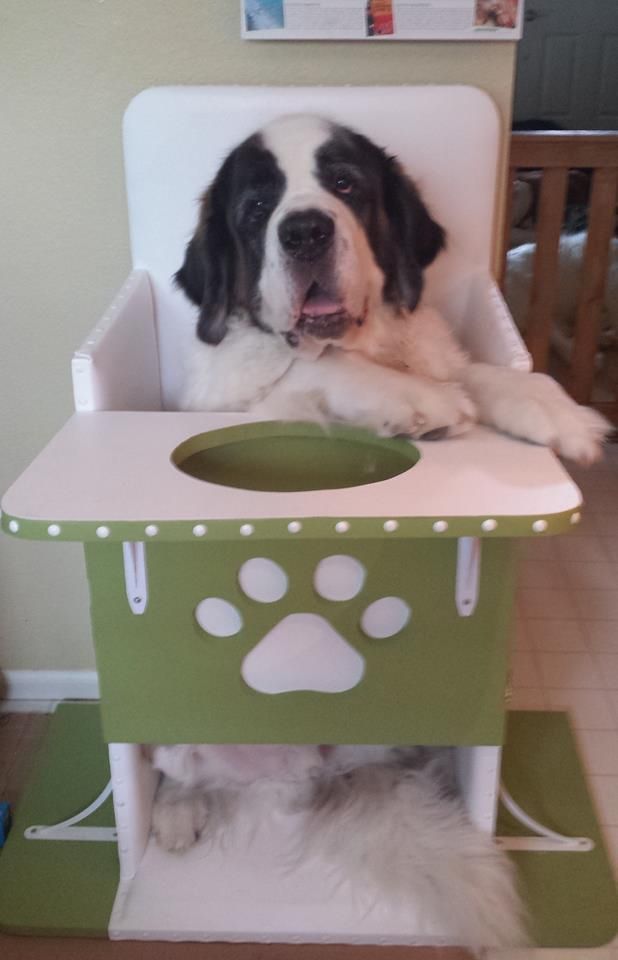Mealtime can be a challenging experience for dogs suffering from certain health conditions, such as megaesophagus. This condition affects the esophagus, making it difficult for dogs to swallow food and water properly. However, with the help of innovative solutions like the Bailey Chair, pet owners can provide their furry friends with a comfortable and effective way to enjoy their meals while improving their overall health and well-being.

What is the Bailey Chair?
The Bailey Chair is a specially designed feeding chair for dogs with megaesophagus. It takes its name from its creator, a veterinarian named Dr. Toby Bailey, who developed the chair to assist his dog suffering from megaesophagus. The chair is constructed with the primary goal of positioning the dog in an upright position during meals, allowing gravity to aid in the digestion process.
How does the Bailey Chair work?
The Bailey Chair provides dogs with an elevated and upright position during mealtime. This positioning is crucial for dogs with megaesophagus or other conditions that affect their ability to swallow food properly. Here's how the Bailey Chair functions:
1. Elevation: The chair is designed with an elevated platform where the dog sits while eating. This elevation helps in preventing food and liquid from flowing back into the esophagus, reducing the risk of regurgitation.
2. Upright Posture: By keeping the dog's head and neck in an upright position, the Bailey Chair promotes the natural downward movement of food into the stomach. Gravity assists in the passage of food, aiding in digestion and reducing the chances of aspiration pneumonia.
3. Support and Stability: The Bailey Chair features a sturdy frame that provides support and stability for the dog while they eat. This ensures that they can comfortably remain in an upright position throughout the meal.
Benefits of using the Bailey Chair

Using the Bailey Chair offers several benefits for both dogs and their owners. Here are some of the key advantages:
1. Improved Digestion: The Bailey Chair facilitates proper digestion by allowing food to travel down the esophagus more smoothly. This can help alleviate symptoms such as regurgitation, bloating, and discomfort.
2. Reduced Aspiration Risk: With the dog in an upright position, the chair helps minimize the risk of aspiration pneumonia. Aspiration pneumonia occurs when food or liquid enters the lungs, and the Bailey Chair helps prevent this by aiding in the correct passage of food into the stomach.
3. Enhanced Nutrient Absorption: When digestion is improved, dogs can absorb nutrients more effectively from their meals. This can contribute to their overall health and well-being, supporting their vitality and immune system.
4. Comfortable Mealtime Experience: The Bailey Chair provides dogs with a comfortable and stable platform for eating. By promoting a relaxed and secure eating environment, the chair can help dogs enjoy their meals without any unnecessary strain or discomfort.
5. Peace of Mind for Owners: Using the Bailey Chair gives owners peace of mind, knowing that they are providing their dogs with the best possible conditions for mealtime. It can alleviate worries about aspiration or difficulties in swallowing, allowing owners to focus on their pet's enjoyment and health.
By utilizing the Bailey Chair, dog owners can significantly improve their furry companions' mealtime experience while addressing the challenges associated with conditions like megaesophagus. The chair's innovative design and beneficial effects on digestion and aspiration risk make it a valuable tool for enhancing the overall well-being of dogs in need.
Who can benefit from using the Bailey Chair?
The Bailey Chair is specifically designed to assist dogs with conditions that affect their ability to eat and swallow properly. While it is primarily intended for dogs with megaesophagus, there are other conditions and situations where the use of the Bailey Chair can be beneficial. Here are some individuals who can benefit from using the Bailey Chair:
1. Dogs with Megaesophagus: Megaesophagus is a condition characterized by the enlargement and reduced motility of the esophagus. Dogs with megaesophagus have difficulty moving food from the mouth to the stomach, often experiencing regurgitation and aspiration. The Bailey Chair helps these dogs maintain an upright posture while eating, allowing gravity to assist with the passage of food and reducing the risk of complications.
2. Dogs with Esophageal Dysmotility Disorders: Dogs with esophageal dysmotility disorders have impaired muscular contractions in the esophagus, which affects the normal movement of food. The Bailey Chair can be beneficial for these dogs, providing the necessary support and positioning to aid in the swallowing process.
3. Dogs with Esophageal Strictures: Esophageal strictures are narrowings or constrictions in the esophagus that can make swallowing difficult for dogs. The Bailey Chair's elevated position can help alleviate the strain on the esophagus, allowing food to pass more easily.
4. Senior Dogs: Older dogs may experience age-related changes in their esophagus, leading to swallowing difficulties. The Bailey Chair can provide support and enhance their ability to eat comfortably.
5. Dogs in Recovery from Surgery or Illness: Dogs recovering from surgeries or illnesses that affect their esophagus or throat may benefit from the use of the Bailey Chair. It can assist in the healing process by minimizing strain during mealtime and promoting proper digestion.
6. Dogs with Muscular Dystrophy: Canine muscular dystrophy affects the muscles responsible for swallowing. The Bailey Chair can aid in mealtime for dogs with this condition, ensuring they can eat comfortably and with less effort.
It is essential to consult with a veterinarian to determine if the Bailey Chair is suitable for your dog's specific condition and needs. They can guide how to incorporate the chair into your dog's routine and ensure it is used safely and effectively.
By providing a secure and upright position during meals, the Bailey Chair offers comfort, improved digestion, and a reduced risk of complications for dogs with various conditions affecting their eating abilities.
Training your dog to use the Bailey Chair
Introducing your dog to the Bailey Chair requires patience and positive reinforcement. Follow these steps to help your dog become comfortable with the chair:
1. Familiarization: Allow your dog to explore the chair when it's not mealtime. Encourage them to sniff and investigate it.
2. Positive Association: Gradually associate the chair with positive experiences. Offer treats and praise while your dog is near or on the chair.
3. Step-by-Step Approach: Begin by placing your dog in the chair for short periods, initially without food. Gradually increase the duration and introduce small amounts of food as they become more comfortable.
4. Reward-Based Training: Reward your dog with treats and praise for sitting calmly in the chair during mealtime. Reinforce positive behavior consistently.
Important considerations before using the Bailey Chair
Before incorporating the Bailey Chair into your dog's routine, it is essential to consider certain factors to ensure the safety and effectiveness of its use. Here are some important considerations to keep in mind:
1. How Often Vet: Before using the Bailey Chair, consult with your veterinarian. They can evaluate your dog's specific condition and guide whether the chair is appropriate and beneficial for your furry friend.
2. Proper Sizing: Ensure that you select a Bailey Chair that is suitable for your dog's size and weight. The chair should provide adequate support and comfort, allowing your dog to sit upright without any discomfort or strain.
3. Supervision: It is crucial to supervise your dog while they are using the Bailey Chair. Although the chair is designed to enhance mealtime safety, it is always best to be present to ensure that your dog is comfortable and does not face any difficulties during eating.
4. Mealtime Adjustments: Some dogs may require adjustments to their mealtime routine when using the Bailey Chair. Your veterinarian can guide you on the appropriate portion sizes, food consistency, and feeding frequency to optimize your dog's digestion and overall well-being.
5. Training and Familiarization: Introducing your dog to the Bailey Chair may require patience and positive reinforcement. Take the time to familiarize your dog with the chair outside of mealtime, allowing them to explore and associate it with positive experiences. Gradually introduce mealtime sessions in the chair, rewarding your dog for calm behavior and successful eating.
6. Potential Allergies or Sensitivities: Take note of any potential allergies or sensitivities your dog may have to the materials used in the construction of the Bailey Chair. Ensure that the chair is made from non-toxic and safe materials to avoid any adverse reactions.
7. Maintenance and Cleaning: Regularly clean and maintain the Bailey Chair to promote hygiene and durability. Follow the manufacturer's instructions for cleaning and disinfecting the chair, ensuring that it remains in good condition for your dog's safety and comfort.
Remember, every dog is unique, and their response to the Bailey Chair may vary. Observe your dog closely during and after mealtime to monitor their comfort and any potential improvements in their eating experience.
Bailey Chair Pricing
The average price of a Bailey Chair can range between $200 to $500. However, it's important to note that this is an estimated average and the actual price may vary depending on factors such as the chair's size, design, materials used, and any additional features or customization options.
Less expensive models may be available at around $200, while higher-end or specialized models with added features could cost up to $500 or more. It's also worth considering that prices may differ between different manufacturers and retailers.
When researching and comparing prices, it's advisable to visit reputable pet supply stores, check online retailers, and directly contact manufacturers for accurate and up-to-date pricing information. This allows you to make an informed decision based on your budget and the specific needs of your dog.
Additionally, consider the overall value of the chair, taking into account factors such as durability, warranty, customer support, and any additional accessories or services included in the price.
Remember, investing in a high-quality Bailey Chair is necessary to provide your dog with a safe and comfortable eating experience. It's recommended to prioritize the chair's quality and suitability for your dog's needs over solely focusing on the price.
Cleaning and maintenance of the Bailey Chair
Proper cleaning and maintenance of the Bailey Chair are essential to ensure hygiene and longevity. Here are some guidelines for cleaning and maintaining the chair:

1. Regular Cleaning: After each meal, clean the Bailey Chair to prevent the buildup of food residue and bacteria. Use mild soap and warm water to wipe down the surfaces of the chair, including the seat, backrest, and frame.
2. Disassembly and Cleaning: If the Bailey Chair is designed to be disassembled, follow the manufacturer's instructions to separate the different components. This allows for a more thorough cleaning and access to hard-to-reach areas. Clean each part individually and reassemble the chair once everything is dry.
3. Avoid Harsh Chemicals: Use gentle cleaning agents and avoid harsh chemicals, as they may damage the materials of the chair or pose a risk to your dog's health. Stick to mild soap or specialized pet-safe cleaning products recommended by the chair manufacturer.
4. Sanitization: Periodically sanitize the Bailey Chair to ensure thorough disinfection. You can use pet-safe sanitizing solutions or diluted white vinegar to kill any remaining bacteria. Rinse the chair thoroughly after sanitizing it to remove any residue.
5. Drying: After cleaning or sanitizing, allow the Bailey Chair to dry completely before using it again. Ensure that all components, including fabric or padding, are fully dry to prevent mold or mildew growth.
6. Inspect for Damage: Regularly inspect the chair for any signs of damage or wear. Check the frame, joints, and fasteners to ensure stability and structural integrity. If you notice any significant damage, contact the manufacturer for guidance on repair or replacement.
7. Storage: If the Bailey Chair is not in use for an extended period, disassemble it and store it in a clean and dry area. This helps protect it from dust, moisture, and potential damage.
By following these cleaning and maintenance practices, you can keep the Bailey chair clean, safe, and in good condition, ensuring optimal functionality and hygiene for your dog's mealtime.
Alternatives to the Bailey Chair
While the Bailey Chair is a popular and effective solution for happy dog with specific needs, there are alternative options that can assist in promoting a comfortable and safe eating environment. Consider the following alternatives:

1. Elevated Feeding Bowls: Elevated feeding bowls raise the height of the food and water bowls, promoting a more upright eating position. This can help facilitate swallowing and reduce the risk of regurgitation or aspiration. However, it is important to choose bowls appropriate for your dog's size and promote a natural eating posture.
2. Slant Boards: Slant boards are inclined surfaces that position the dog at an angle during meals. This angle aids in digestion by utilizing gravity to move food down the esophagus. Slant boards can be especially helpful for dogs with mild to moderate swallowing difficulties.
3. Assisted Feeding Techniques: In some cases, assisted feeding techniques may be necessary. This involves manually supporting the dog's neck and head while they eat, ensuring proper positioning and swallowing. It is critical to work closely with your veterinarian to learn the correct techniques and ensure your dog's safety.
When considering alternatives to the Bailey Chair, consult with your veterinarian to determine the most suitable option based on your dog's specific condition and needs. They can provide personalized recommendations and guidance to help you choose the best solution.
Remember, the ultimate goal is to provide your dog with a comfortable and safe eating experience that addresses their specific challenges and promotes proper digestion.

Final Thoughts
The Bailey Chair offers a practical and beneficial solution for good family dogs with megaesophagus or other conditions affecting their eating habits. By providing a comfortable and upright position during meals, the chair improves digestion, reduces the risk of complications, and enhances the overall well-being of your beloved canine companion. Consult with your veterinarian to determine if the Bailey Chair is a suitable option for your dog, and enjoy watching your furry friend experience improved mealtime comfort and satisfaction.
Frequently Asked Questions (FAQs)
1. Q: Can any breed of dog use the Bailey Chair?
A: Yes, the Bailey Chair can be used by dogs of all breeds and sizes.
2. Q: Is the Bailey Chair adjustable?
A: Yes, many Bailey Chairs come with adjustable features to accommodate dogs of different sizes.
3. Q: Can the Bailey Chair be used for puppies?
A: Yes, puppies with megaesophagus or similar conditions can benefit from the Bailey Chair.
4. Q: Can I leave my dog unattended in the Bailey Chair?
A: It is required to supervise your dog during mealtime, especially when using the Bailey Chair.
5. Q: Where can I purchase a Bailey Chair?
A: You can find Bailey Chairs at select veterinary clinics, online pet supply stores, or through specialized manufacturers.

